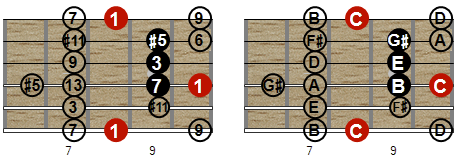Chord Scales
In terms of harmony, there are two types of notes: chord tones and non-chord tones. Chord tones are the root, third, fifth, and seventh, and non-chord tones are the remaining notes. There are two types of non-chord tones: tensions and chromatic notes.
Tensions are notes that can be integrated into the harmony as embellishments of a chord. These notes will be a major second above the chord tones (root, third, fifth). When you add a major second to each of the scale degrees, you will create a perfect jazz scale, or a chord scale. Adding a minor second to the chord tones will give you chromatic notes, which are too dissonant for harmony, and should be used carefully. Chromatic notes are often called avoid notes.
There are eight different chord scales based on the eight different seventh chords. Adding the major second from each chord tone of the triad gives you each note for the chord scale.
Watch the video below to learn the fastest way to derive the chord scales for the diatonic chords in C major.
Major Seventh Chord Scale (1-3-5-7-9-#11-13)
If you add a major second above the 1, 3, and 5 chord tones in a major seventh chord, you get tensions 9, #11, and 13. The chord scale (1-3-5-7-9-#11-13) is Lydian, the fourth mode of the major scale. The combined notes of the C major seventh chord and the D major triad (C-E-G-B + D-F#-A) make up the C Lydian scale. 
Minor Seventh Chord Scale (1-♭3-5-♭7-9-11-13)
If you add a major second above the chord tones (1, ♭3, and 5) of a Cmin7 chord, you get tensions 9, 11, and 13. The chord scale (1-♭3-5-♭7-9-11-13) is Dorian, the second mode of the major scale. The combined notes of the C minor seventh chord and the D minor triad (C-E♭-G-B♭ + D-F-A) make up the C Dorian scale.

Dominant Seventh Chord Scale (1-3-5-♭7-9-#11-13)
The chord scale for a dominant seventh is similar to the chord scale for a major seventh chord because they both have a major triad. The tensions are 9, #11, and 13. The chord scale is 1-3-5-♭7-9-#11-13. The perfect jazz scale for a C7 is C-E-G-B♭-D-F#-A. The name of this scale is Lydian Dominant or Lydian ♭7, the fourth mode of the melodic minor scale.

Half-Diminished Seventh Chord Scale (1-♭3-♭5-♭7-9-11-♭13)
If you add a major second to the 1, ♭3, and ♭5 you will get tensions 9, 11, and ♭13. Your chord scale is 1-♭3-♭5-♭7-9-11-♭13. The perfect jazz scale for a Cmin7♭5 is C- E♭-G♭-B♭-D-F-A♭. Alternatively, add a diminished triad a major second above the root (C-E♭-G♭-B♭ + D-F-A♭). The name of this scale is Aeolian ♭5 or Locrian natural 2, and it is the sixth mode of the melodic minor scale.

For each of the above scales, keep in mind that notes a minor second above the chord tones are avoid notes. For example, in the Major Seventh and Dominant Seventh chord scales, the 4 is an avoid note because it is a minor second above the 3.
Minor Major Seventh Chord Scale (1-♭3-5-7-9-11-13)
If you add a major second to the 1, ♭3, and 5 you will get tensions 9, 11, and 13. The chord scale is 1-♭3-5-7-9-11-13. The perfect jazz scale for a CminMaj7 is C, E♭, G, B, D, F, A. Alternatively, add a minor triad a major second up from the root note to find your tensions (C-E♭-G-B + D-F-A). The name of this scale is melodic minor, the first mode of the melodic minor scale.

Augmented Major Seventh/Major Seventh #5 Chord Scale (1-3-#5-7-9-#11-13)
With regard to this chord, there is an exception to the rule of adding a major second to the chord tone 5, since we have an altered fifth or #5 in this chord. You add a major second only to the 1 and 3 and not the #5. As an exception, you are allowed to add a minor second above the #5 which is the chord tone 6 or 13. So, the tensions for this chord are 9, #11, and 13 (root + 2 = 9, third + 2 = #11, sharp fifth + min2 = 6/13). Your chord scale is 1-3-#5-7-9-#11-13. The perfect jazz scale for a Cmaj7#5 is C, E, G#, B, D, F#, A. Alternatively, add a major triad a major second up from the root note to find your tensions (C-E-G#-B + D-F#-A). The name of this scale is Lydian#5, the third mode of the melodic minor scale.

Altered Dominant Chord Scale (1-3-♭5-♭7-♭9-#9-♭13)
On dominant chords you can add a minor second only above the root and fifth. A minor second above the root is a ♭9 or a minor ninth. Because there is an augmented second from ♭9 to 3, you are allowed to add a tension a major second above ♭9 which is #9. A major second above ♭5 is ♭13/#5. The tensions for this chord are ♭9, #9, ♭13. Your chord scale would be 1-3-♭5-♭7-♭9-#9-♭13. For a C7alt, the perfect jazz scale is C, E, G♭, B♭, D♭, D#, A♭. This is an altered scale, the seventh mode of the melodic minor scale.

Diminished Seventh Chord Scale (1-♭3-♭5-♭♭7-9-11-♭13-7)
If you add a major second to the 1, ♭3, ♭5 and ♭♭7 you will get tensions 9, 11, ♭13 and 14. A major second above ♭♭7 or 6 is 7. But since 7 is considered a chord tone, the compound interval that is equivalent to a 7 is 14 (7 + 7). You end up with an eight-note chord scale. Your chord scale would be 1-♭3-♭5-♭♭7-9-11-♭13-7/14. For a C°7, the perfect jazz scale would be C, E♭, G♭, B♭♭, D, F, and A♭. Alternatively, add a diminished seventh chord a major second above the root (C-E♭-G♭-B♭♭ + D-F-A♭-B). The name of this scale is a symmetrical diminished scale. There are only 3 diminished scales – C, C# and D.

